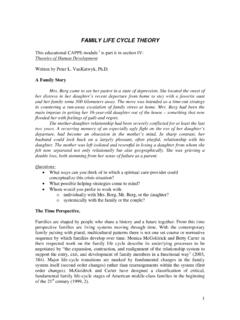Transcription of What is ‘Development’?
1 9 development is a concept which is contested both theoretically and politically, and is inherently both complex and ambiguous .. Recently [it] has taken on the limited meaning of the practice of development agencies, especially in aiming at reducing pov-erty and the Millennium development Goals. (Thomas, 2004: 1, 2)The vision of the liberation of people and peoples, which animated development practice in the 1950s and 1960s has thus been replaced by a vision of the liberaliza-tion of economies. The goal of structural transformation has been replaced with the goal of spatial .. The dynamics of long-term transformations of econ-omies and societies [has] slipped from view and attention was placed on short-term growth and re-establishing fi nancial balances. The shift to ahistorical performance assessment can be interpreted as a form of the post-modernization of development policy analysis.
2 (Gore, 2000: 794 5)Post-modern see [poverty and development ] as socially constructed and embedded within certain economic epistemes which value some assets over others. By revealing the situatedness of such interpretations of economy and pov-erty, post-modern approaches look for alternative value systems so that the poor are not stigmatized and their spiritual and cultural assets are recognized. (Hickey and Mohan, 2003: 38)One of the confusions, common through development literature is between devel-opment as immanent and unintentional .. and development as an inten-tional activity. (Cowen and Shenton, 1998: 50)If development means good change, questions arise about what is good and what sort of change Any development agenda is .. not to consider good things to do is a tacit surrender fatalism. Perhaps the right course is for each of us to refl ect, articulate and share our own accepting them as provisional and fallible.
3 (Chambers, 2004: iii, 1 2)Since [ development ] depend[s] on values and on alternative conceptions of the good life, there is no uniform or unique answer. (Kanbur, 2006: 5) IntroductionWhat is the focus of development Studies (DS)?1 What exactly are we interested in? In this fi rst chapter we discuss perhaps the fundamental question for DS: namely what is development ? Following Bevan s approach (2006: 7 12), which has been outlined What is development ?CHAPTER ONE5070-Sumner-Ch01 95070-Sumner-Ch01 912/22/07 10:03:19 AM12/22/07 10:03:19 AM International development Studies 10 in our Introduction, this is the fi rst knowledge foundation or the focus or domain of study .In this introduction we discuss the opening quotations to this chapter in order to set the scene . The writers who have been cited are, of course, not unique in address-ing the meaning of development , but the selections have been made in order to introduce the reader to the wide range of perspectives which would be an understatement to say that the defi nition of development has been controversial and unstable over time.
4 As Thomas (2004: 1) argues, development is contested, .. complex, and ambiguous . Gore (2000: 794 5) notes that in the 1950s and 1960s a vision of the liberation of people and peoples dominated, based on structural transformation . This perception has tended to slip from view for many contributors to the development literature. A second perspective is the defi nition embraced by international development donor agencies that Thomas notes. This is a defi nition of development which is directly related to the achievement of poverty reduction and of the Millennium development Goals (MDGs).There is a third perspective from a group of writers that Hickey and Mohan (2003: 38) broadly identify as post-modernists .2 The post-modern position is that devel-opment is a discourse (a set of ideas) that actually shapes and frames reality and power relations. It does this because the discourse values certain things over others.
5 For example, those who do not have economic assets are viewed as inferior from a materialistic viewpoint. In terms of real development there might be a new discourse based on alternative value systems which place a much higher value on spiritual or cultural assets, and within which those without signifi cant economic assets would be regarded as having signifi cant is, not surprisingly, considerable confusion over the wide range of divergent conceptualizations, as Cowen and Shenton (1998: 50) argue. They differentiate between immanent (unintentional or underlying processes of) development such as the development of capitalism, and imminent (intentional or willed ) development such as the deliberate process to develop the Third World which began after World War II as much of it emerged from common theme within most defi nitions is that development encompasses change in a variety of aspects of the human condition.
6 Indeed, one of the simplest defi nitions of development is probably Chambers (2004: iii, 2 3) notion of good change , although this raises all sorts of questions about what is good and what sort of change matters (as Chambers acknowledges), about the role of values, and whether bad change is also viewed as a form of the theme of change may be overriding, what constitutes good change is bound to be contested as Kanbur (2006: 5) states, because there is no uniform or unique answer . Views that may be prevalent in one part of the development com-munity are not necessarily shared by other parts of that community, or in society more this chapter we discuss these issues and we seek to accommodate the diversity of meanings and interpretations of development . In Section 2 we critically review differing defi nitions of development . In Section 3 we ask what different defi nitions 5070-Sumner-Ch01 105070-Sumner-Ch01 1012/22/07 10:03:20 AM12/22/07 10:03:20 AM What is development ?
7 11 mean for the scope of DS ( what is a developing country). Section 4 then turns to indicators of development with Section 5 summarizing the content of the What is development ?In this section we set up three propositions about the meaning of development (see Figure ). It is inevitable that some members of the development community will dismiss one or more of these, while others will argue strongly in favour. Even within individually contested conceptualizations there is space for considerable diversity of views, and differing schools of thought also tend to overlap. This over-all multiplicity of defi nitional debates includes a general agreement on the view that development encompasses continuous change in a variety of aspects of human society. The dimensions of development are extremely diverse, including economic, social, political, legal and institutional structures, technology in various forms (including the physical or natural sciences, engineering and communica-tions), the environment, religion, the arts and culture.
8 Some readers may even feel that this broad view is too restricted in its scope. Indeed, one might be forgiven for feeling that there is just too much to know now (as, indeed, there always was) (Corbridge, 1995: x).We would argue that there are three discernable defi nitions of development (see Figure ). The fi rst is historical and long term and arguably relatively value free development as a process of change. The second is policy related and evaluative or indicator led, is based on value judgements, and has short- to medium-term time horizons development as the MDGs, for example. The third is post-modernist, drawing attention to the ethnocentric and ideologically loaded Western conceptions of development and raising the possibilities of alternative conceptions. development as a long termprocess ofstructuralsocietaltransformation development as a short-to-medium termoutcome ofdesirabletargets development as a dominant discourse ofwesternmodernityFigure What is development ?
9 5070-Sumner-Ch01 115070-Sumner-Ch01 1112/22/07 10:03:20 AM12/22/07 10:03:20 AM International development Studies 12 development as a long-term process of structural societal transformationThe fi rst conceptualization is that development is a process of structural societal change. Thomas (2000, 2004) refers to this meaning of development as a process of historical change . This view, of structural transformation and long-term transfor-mations of economies and societies , as Gore noted, is one that predominated in the 1950s and 1960s in particular. Today, one might argue that this defi nition of develop-ment is emphasized by the academic or research part of the development community but that there is less emphasis on this perspective in the practitioner part of the development community (as has already been broached in our Introduction).The key characteristics of this perspective are that it is focused on processes of structural societal change, it is historical and it has a long-term outlook.
10 This means that a major societal shift in one dimension, for example from a rural or agriculture-based society to an urban or industrial-based society (what is sometimes called the shift from traditional to modern characteristics), would also have radical implica-tions in another dimension, such as societal structural changes in the respective posi-tions of classes and groups within the relations of production for example (by which we mean the relationship between the owners of capital and labour). This means that development involves changes to socio-economic structures including ownership, the organization of production, technology, the institutional structure and this conceptualization development relates to a wide view of diverse socio-economic changes. The process does not relate to any particular set of objectives and so is not necessarily prescriptive. Equally, it does not base its analysis on any expecta-tions that all societies will follow approximately the same development countries change over time, and generally experience economic growth and societal change.















